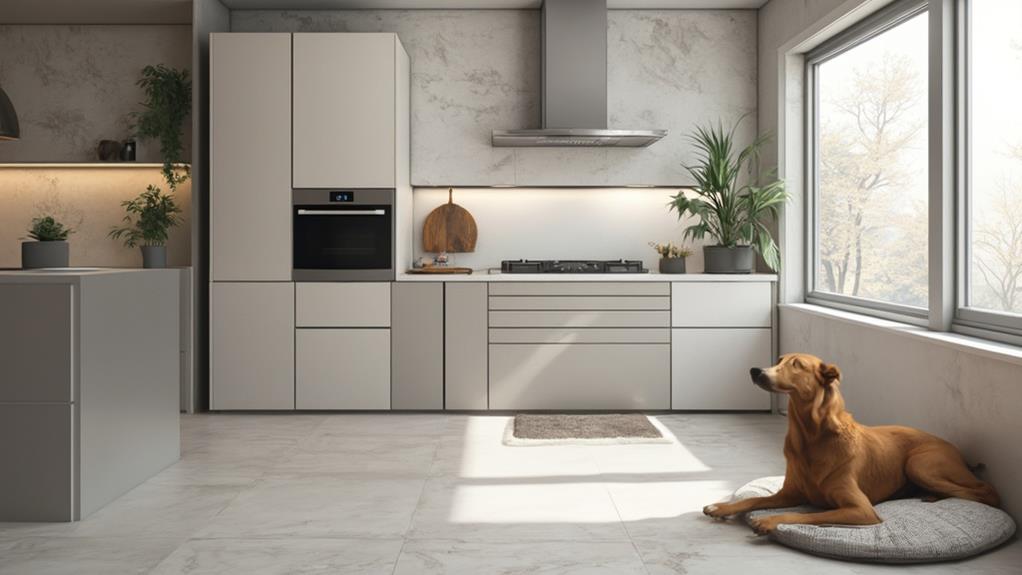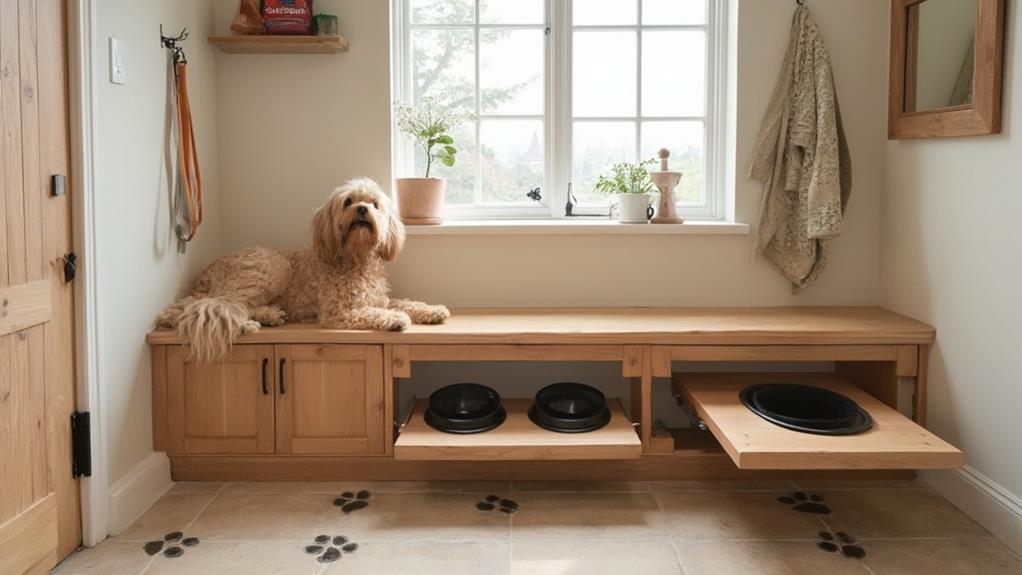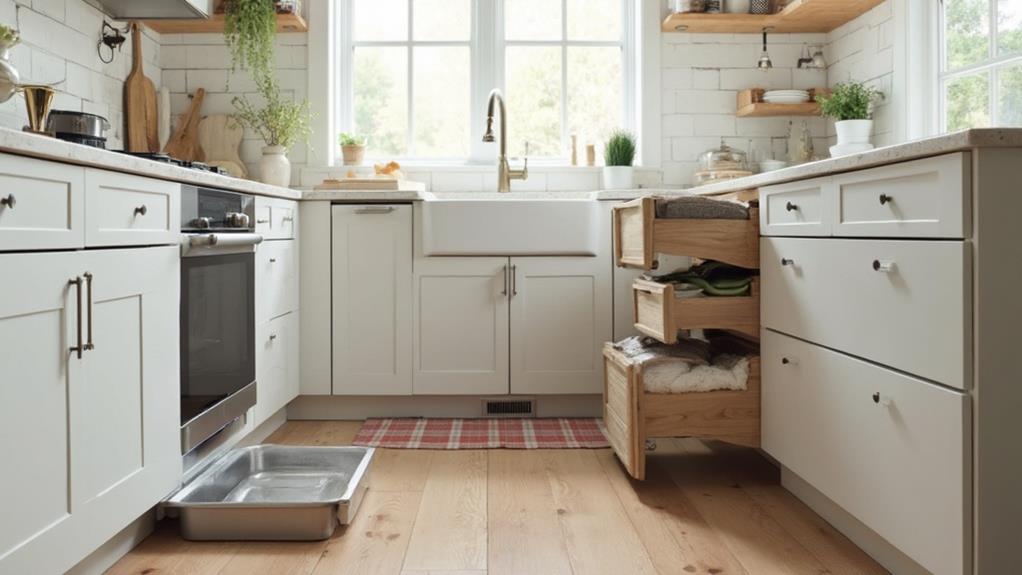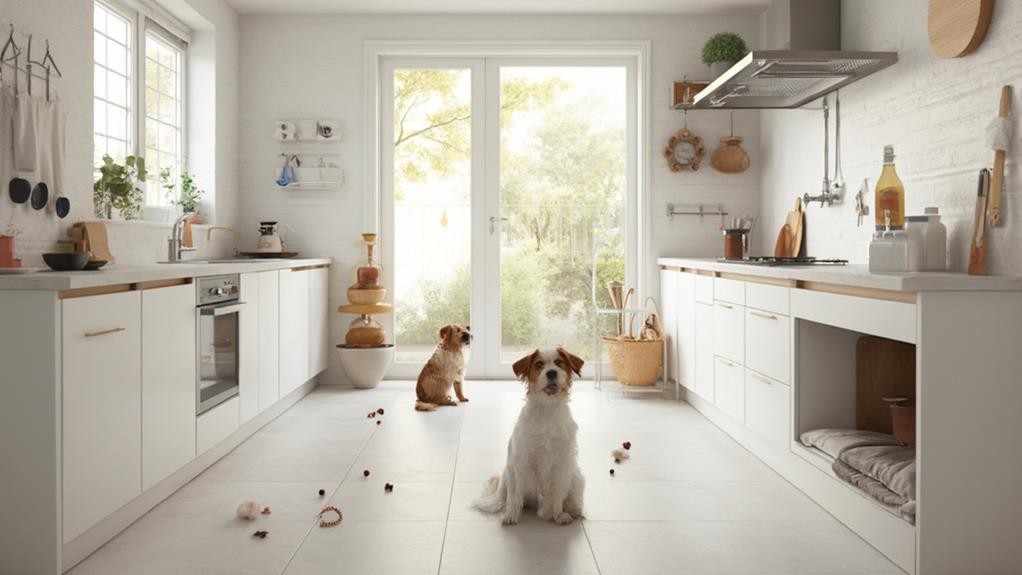To create a pet-friendly kitchen, focus on durable materials like quartz countertops and luxury vinyl flooring that can withstand scratches and spills. Incorporate smart storage solutions, such as pull-out drawers for pet food and dedicated cabinets for supplies. Design a feeding station with elevated bowls for larger dogs and separate areas for cats. Prioritize safety by using child-proof locks, securing electrical cords, and storing hazardous items out of reach. Create designated pet zones, including a cozy nook for beds and a grooming area. With these considerations, you'll craft a kitchen that's both functional and welcoming for your furry friends. Discover more ways to make your kitchen truly pet-friendly.
Pet-Safe Materials and Flooring

Three key considerations for pet-safe materials and flooring in your kitchen are durability, ease of cleaning, and comfort for your furry friends. When choosing countertops, opt for scratch-resistant materials like quartz or granite. These surfaces can withstand accidental paw scratches and are easy to wipe clean.
For cabinets, select sturdy wood or metal finishes that can handle occasional bumps from excited pets.
Flooring is crucial in a pet-friendly kitchen. Avoid porous materials like hardwood, which can absorb spills and odors. Instead, consider luxury vinyl planks, ceramic tiles, or sealed concrete. These options are water-resistant, scratch-resistant, and simple to clean. For added traction, choose textured surfaces to prevent slips.
Don't forget about your pet's comfort. Place non-slip mats near food and water bowls to catch spills and provide a stable surface. If you have a senior pet, consider heated floor mats in their favorite spots for extra warmth. Lastly, ensure any cleaning products you use are pet-safe and store them securely out of reach. By selecting the right materials and flooring, you'll create a kitchen that's both stylish and pet-friendly.
Smart Storage Solutions
Now that you've created a safe and comfortable environment for your pets, let's focus on keeping your kitchen organized with smart storage solutions. Consider installing pull-out drawers for pet food and treats, making them easily accessible while keeping them out of sight.
A dedicated cabinet for pet supplies, including bowls, leashes, and grooming tools, will help you maintain a clutter-free space.
Utilize vertical space by adding hooks or pegboards to hang collars, leashes, and small accessories. Install a built-in feeding station with food and water bowls that can be tucked away when not in use. This prevents tripping hazards and keeps your kitchen looking tidy.
For smaller items like medications or supplements, use clear, labeled containers in a designated drawer. Consider a wall-mounted dispenser for waste bags, making them readily available for walks. If you have a cat, incorporate a hidden litter box area within a cabinet or island, ensuring proper ventilation.
Don't forget about toy storage – use decorative baskets or bins that complement your kitchen's aesthetic. By implementing these smart storage solutions, you'll create a functional, organized space that caters to both you and your pets' needs.
Feeding Station Design

A well-designed feeding station is essential for a pet-friendly kitchen. When creating your pet's dining area, consider both functionality and aesthetics. Choose a location that's out of the main traffic flow but still easily accessible. You'll want to keep food and water bowls away from appliances and cabinets to prevent spills and messes.
Invest in elevated feeders for larger dogs to reduce strain on their necks and improve digestion. For cats, place food and water bowls separately, as they prefer drinking away from their food source. Use non-slip mats under the bowls to catch spills and prevent sliding.
Incorporate storage for pet food and treats nearby. Pull-out drawers or cabinets with airtight containers work well to keep food fresh and pests at bay. Include a small shelf for storing measuring cups, supplements, and medications.
Consider adding a water fountain for pets who prefer running water. This can encourage hydration and add a stylish element to your kitchen. Finally, choose materials that are easy to clean and maintain, such as stainless steel or ceramic bowls and water-resistant flooring around the feeding area.
Safety Features and Precautions
Your pet's safety should be a top priority when designing a pet-friendly kitchen. Start by securing cabinets with child-proof locks to prevent curious pets from accessing harmful substances or sharp objects. Install induction cooktops or stove knob covers to avoid accidental burner activation. Choose non-slip flooring materials to prevent your pet from slipping and injuring themselves.
Keep electrical cords hidden or use cord protectors to prevent chewing hazards. Opt for rounded countertop edges to reduce the risk of injury if your pet jumps up. Store cleaning products, chemicals, and medications in high, locked cabinets out of your pet's reach. Use pet-safe plants for décor and avoid toxic varieties like lilies or aloe vera.
Consider installing a pet gate to restrict access to the kitchen during cooking or when you're not present. Place trash cans in secure locations or use models with locking lids. Be mindful of small items like twist ties or rubber bands that could pose choking hazards. Regularly clean spills and crumbs to prevent your pet from ingesting harmful substances. By implementing these safety features and precautions, you'll create a kitchen environment that's both functional and safe for your furry friend.
Incorporating Pet-Friendly Zones

Creating dedicated pet-friendly zones in your kitchen can make the space more comfortable and functional for both you and your furry companions. Consider designating a specific area for pet food and water bowls, away from high-traffic zones to prevent tripping hazards. Install built-in feeding stations with pull-out drawers or recessed niches to keep bowls off the floor when not in use.
Incorporate a cozy nook for your pet's bed or crate, ensuring it's tucked away from cooking areas but still within sight. This gives your pet a safe space to relax while you're in the kitchen. Add a built-in pet gate to restrict access to certain areas when necessary, or install a pet door for easy outdoor access.
Create storage solutions for pet supplies, such as a dedicated cabinet or pantry section for food, treats, and medications. Include hooks or a small closet for leashes, collars, and toys. If space allows, consider adding a pet grooming station with a low sink or washing area, complete with storage for grooming tools. By thoughtfully incorporating these pet-friendly zones, you'll create a kitchen that caters to both human and animal needs.
Conclusion
You've now got the tools to create a kitchen that's as welcoming to your furry friends as it is to you. Like a well-designed playground, your pet-friendly kitchen will be a safe and enjoyable space for all. Remember, it's about finding the right balance between functionality and pet-centric features. With these ideas in mind, you'll transform your kitchen into a harmonious haven where both you and your pets can thrive together.

